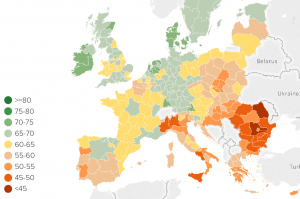When Habitat for Humanity’s ReStore coordinator walked over the concrete floors through 3,500 square feet to build shelves and store goods in the nonprofit’s new retail store in Clovis, Calif., this past July, neither he nor his organization expected to exceed the retail expectations.
"We thought we could net $15,000 this year," said Tony Miranda, executive director for Habitat for Humanity Fresno County. "However, because of the donation of the space and individual donations for inventory, we have grossed over $15,000 in two months — six times faster than expected."
To have such a success, nonprofit retail operations face the process of tying the mission to the items sold, finding a way to coordinate the products, and dealing with the space needed.
Nonprofit retailers also have to discover ways to merchandize the items, as well as create products from the organization’s collections.
Habitat’s mission to develop communities for people in need usually provides the screws, stoves or light fixtures to fill a new house. The donated supplies left over become prime inventory for the ReStore.
"It’s a natural extension that is in line with our building philosophy,"
Miranda said. "This is a recycling part of our economic development so we can provide discounted material for people with low income levels."
Habitat in Fresno is a medium-sized affiliate with an annual budget of approximately $1 million. The nonprofit constructed seven homes during the past year. The ReStore is a new operation for Fresno, although it remains a concept widely used by other Habitats around the country.
Retail operations need a coordination of items. For Habitat, the management occurs with a project manager who arrives at the staging area to oversee supply donations. A ReStore coordinator manages the store. The project manager also picks up excess supplies for the store from project sites, using a rented truck around twice a month.
Deciding on the cost structure for retail products can require a lot of time. "It’s a home improvement thrift shop," Miranda said.
The coordinator visits other hardware stores to assess the market rates. The strategy aims to have discounted prices to help the Habitat’s audience. "New items of lesser value are being charged at 50 cents on the dollar," Miranda said. "If someone donated a new stove, we would move that to 75 percent of market value, and it’s down to 30 percent for something old and used."
Obtaining the items can be a logistical challenge. "We encourage people to bring their donated items into the store when we have a sale on Saturdays," he said. "Otherwise, the project manager uses a rented truck to pick up items from around town."
Coordinating items means marketing for the donations. Habitat seeks to reach out to local contractors for new material to supply the store.
Tracking sales by department will help Miranda see where the money is coming from and what people want. But, that level of sophistication is still a few months away.
The retail process means dealing with space. For Habitat, the rule of thumb calls for 10,000 to 15,000 square feet.
"Insufficient space and staffing are the two common, limiting factors," Miranda said. "But the recommended space costs a pretty penny and we wanted to have a sense of some success before investing that amount of money." Miranda was lucky to have the city donate the space, although he hopes to move by next year.
The ReStore income is mission-related so the dollars generated don’t trigger federal unrelated business income tax. "The retail operation can be a great way to provide a stable source of income that doesn’t ebb and flow like grants," he said.
While the effort acts as resource development, the retail provides an income stream of dollars that supplies 20 to 30 percent of Miranda’s operating budget. "That is a substantial stream that helps us grow," he said.
It’s all about product Merchandising is crucial for the Society of St. Vincent de Paul of Alameda County in California. The nonprofit distributes vouchers to local churches for use in the store. The nonprofit has also sought merchandising tips from the REDF, formerly known as the Roberts Enterprise Development Fund. "We brought in over $2 million in sales last year," said Melanie Anguay, director of retail services. St. Vincent runs four thrift stores, aiming to supply home furnishings for low-income people. "We’re geared to helping people create a home," she said.
The voucher program works with offices within Catholic churches. St. Vincent volunteers, called Vincentians, set up visits to see needy people, then distribute discount vouchers between $20 and $200 in value.
But the process of retail calls for expertise in placing items and arranging shelves. "Thrift stores across the country are struggling because of competition," Anguay said. Part of the examination is of what customers buy in each store. Figures are assessed from profits by the square footage. "Merchandising depends on the demographic factors in an area and which items draw different customers," said Minakshi Radhakrishnan, MBA intern from REDF.
The process of retail requires a product mix to increase the results. "Placement of items depends on a visual effect," she said. "The racks should be placed to be appealing, and easy, impulse purchasing does better in the front of the store while furniture should be in the rear."
Another aspect of the retail process eyes having customers return as fast as possible. That means the inventory has to keep pace with new and exciting items.
"We’re looking to target the items that bring in the most dollars," Anguay said. "One example is to look at furniture and try to partner with furniture manufacturers who can donate supplies."
Historic collections Can an item in a nonprofit’s collection become a retail product without ever leaving the organization’s archives? Right now, the National Trust for Historic Preservation in Washington, D.C., is opening up four furniture lines and 10 carpets from collections so that designers and manufacturers can create retail products.
Elements or patterns in the furniture or carpets become parts of products for the designers. The designers don’t reproduce, but rather take elements from the furniture to make a new line.
"The brand is called Design in America," said Crista Gibbons, business development and licensing manager for the Trust. "We were chartered by Congress in 1949 to protect important places in America, and since leaving federal funding in the late 90’s we have had to close the gap by being creative."
The Trust obtains some money from foundations, but needed a business venture to increase organizational capacity. One way is licensing, and the program brings in more than $2 million a year.
In the past, licensing dealt more with reproductions than products. "The angle the Hammary furniture company took was to be inspired by the past," Gibbons said. "So the Prairie, Traditional, Art Deco and Mountain Lodge motifs each appear in the lines and patterns in new items."
The carpet company, Karastan, found inspiration from the Trust’s Greek Revival homes in Virginia, and Gothic castles in Tarrytown, N.Y., among others, according to Gibbons.
Karastan searched parts of the homes from molding to iron gates to a floral pattern in a tapestry to devise patterns for carpet products. In one example, a home in Cedar Rapids, Iowa, presented a terra-cotta pattern on an exterior and the company took that starburst design for a pattern in a new carpet.
"We’re looking for additional partners in home furnishings like lighting companies," she said. "We offer an exciting way to open doors that would not usually be accessible to manufacturers."
Designers find an advantage beyond the logo as they accrue good will with a feel-good story, according to Gibbons.
For the Trust, the royalty depends on the item. A paint product could be lower because of a greater distribution while a higher fee for furniture could occur because of the higher bracket. "Gaining royalty revenue keeps the lights on so we can fulfill the mission," Gibbons said.
The use of a collection so others can produce a product is a variation to the usual retail store like a Goodwill.
Instead of targeting an audience to come into the store, the Trust has to target designers to let them know details in the collection. That means dealing with a licensing agency to develop contacts.
Unlike other retailers, the Trust doesn’t deal with inventory control or fulfillment. "We were in the catalogue business years ago and lost money," Gibbons said. "It’s difficult to manage fulfillment especially with small orders so that our model now is more successful — it just depends on the partner because we’re only providing the inspiration for the product without the marketing costs."
Whichever way the product arrives, retail can help nonprofits. In the words of St. Vincent’s Anguay, "retail provides a constant cash flow for a nonprofit."
Use the social enterprise of the mission for products in a thrift store. That’s the formula for the Society of St. Vincent de Paul of Alameda County in California.
The nonprofit discovered a use for some discarded or trashed books and game boards. These "waste" products are rescued from the garbage dump in a "found art" program that appears as retail products in the Alameda thrift store.
"We pull items from our waste stream to create green products, like purses, tool belts, note books, or aprons," said Melanie Anguay, director of retail services for the Society.
"Many of the books have interesting covers or really beautiful art," she said. "Our artists remove the pages with the most interesting or unusual covers and remake them into trendy gift bags, boxes, and purses." NPT
***Tom Pope, a New York City-based journalist, writes about management issues.











